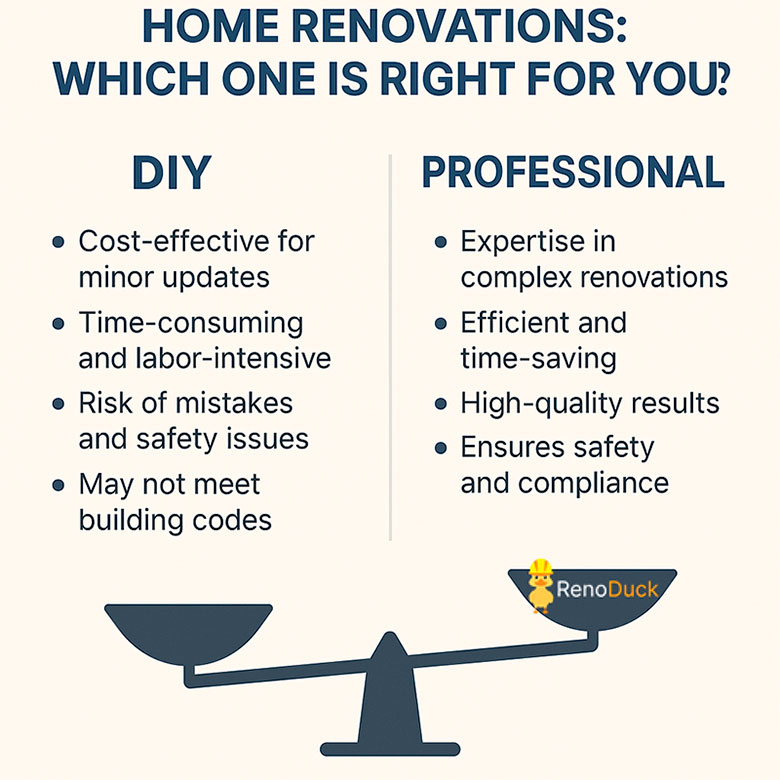Key Takeaways
- DIY renovations may be suitable for minor cosmetic updates, but they often involve hidden costs, extended timelines, and code compliance risks.
- Professional home renovators deliver higher quality results, adhere to Ontario building codes, and manage all technical, legal, and logistical complexities.
- Hiring experts ensures long-term value by minimizing costly errors, future repairs, and inefficient material use.
- In Ontario, most structural or mechanical projects legally require permits and inspections — something professionals are equipped to handle.
Table of Contents:
- More Than Just a Project – It’s a Strategic Decision
- Understanding the Scope: Is Your Project DIY-Friendly?
- Budgeting Beyond the Surface: Understanding True Costs
- Time, Energy, and Project Flow
- Compliance, Safety, and Long-Term Reliability
- Case-by-Case: When DIY Works and When It Doesn’t
- Long-Term Value: What Saves You Money in the End?
- Conclusion: Strategic Renovation Starts with the Right Decision
- Frequently Asked Questions

More Than Just a Project – It’s a Strategic Decision
Homeowners across Ontario—from Toronto and Newmarket to Brampton and Ajax—face a fundamental decision before starting a renovation: take on the work themselves or trust professionals to do it. While home renovation DIY may seem attractive due to perceived cost savings or the satisfaction of hands-on work, it often comes with hidden pitfalls: delays, poor workmanship, non-compliance with building codes in the GTA, and higher long-term costs.
On the other hand, professional home renovators offer a structured, code-compliant process supported by licensed trades, designers, and project managers. This article examines both paths—DIY vs. professional—to help you make an informed decision that aligns with your goals, your property, and Ontario’s renovation environment.
Understanding the Scope: Is Your Project DIY-Friendly?
Small-Scale Projects That Are Manageable for Homeowners
Some tasks are well-suited for DIY, especially if you have tools, time, and attention to detail:
- Painting rooms
- Replacing cabinet hardware
- Basic landscaping
- Minor diy home repairs (like caulking or swapping a faucet)
These improvements carry low risk and typically don’t require permits.
When to Hire Professionals
For any project involving structure, mechanical systems, or finish work in high-moisture areas, professional renovation services are the standard in Ontario. Examples include:
- Bathroom renovations involving plumbing or waterproofing
- Kitchen renovation with custom cabinetry and electrical work
- Basement conversions, especially if building a legal basement apartment
- Structural changes (e.g., removing a load-bearing wall)
- Anything that touches HVAC, electrical, or fire-rated assemblies
A critical point in Ontario is the requirement for home renovation permits. Most municipalities require permits for more than cosmetic changes. Mistakes in non-permitted work may result in future fines, safety risks, or denial of insurance claims.
Budgeting Beyond the Surface: Understanding True Costs
DIY May Seem Cheaper – But Is It?
Many homeowners assume that doing the work themselves means saving money. However, costs can accumulate quickly:
- Purchasing or renting tools
- Material waste due to miscalculations
- Re-doing work that fails inspection or doesn’t meet aesthetic standards
- Health and safety risks
DIY house remodel projects often overlook hidden costs, especially in older Ontario homes with sloped floors, aging plumbing, or outdated electrical systems.
The Cost of Quality: Hiring a Contractor
Yes, hiring a contractor for home renovation means paying for skilled labour, project management, and permits. But this investment brings:
- Code-compliant work from licensed contractors in Ontario
- Correct insulation and subfloor systems (e.g., DRICORE panels with R-value for basement warmth)
- Vendor discounts on materials
- Coordinated schedules that minimize delays
For example, understanding how much basement renovation cost often reveals how quickly small errors in DIY can become expensive corrections.
Time, Energy, and Project Flow
The Reality of DIY Timelines
Time is an underestimated resource in home improvement work. Even if you’re handy, managing procurement, demolition, and sequencing tasks like electrical rough-ins, drywalling, and trim installation can stretch over months. If mistakes occur, timelines are extended further.
Moreover, few homeowners can dedicate full days to renovation without impacting their personal or professional lives.
Professionals Minimize Disruption
A renovation company like RenoDuck assigns project coordinators and site managers who:
- Schedule trades in a logical order (e.g., HVAC before drywall)
- Minimize downtime between steps
- Keep work areas clean and compliant
- Communicate with building inspectors
This coordination is especially important for GTA home renovations, where municipal inspection schedules can delay unprepared projects.
Compliance, Safety, and Long-Term Reliability
DIY Comes with Risks
Homeowners working without a deep understanding of Ontario’s building requirements can inadvertently:
- Violate building codes in the GTA
- Install unsafe electrical wiring
- Use non-approved materials
- Miss crucial waterproofing steps
Professional Standards and Inspections
By contrast, professional remodeling includes:
- Adherence to current OBC (Ontario Building Code) and ESA guidelines
- Proper permits and inspection documentation
- Correct sequencing and anchoring of framing
- Use of VOC-free paints, tested flooring types, and safe electrical panels
“Improperly installed basement flooring without a proper subfloor can cause heat loss through the slab—an expensive mistake in Ontario’s winters.”
— Alex, Founder of RenoDuck
Case-by-Case: When DIY Works and When It Doesn’t
| Renovation Type | DIY Viable? | Professional Recommended? |
| Interior painting | ✅ | – |
| New cabinet installation | ⚠️ | ✅ |
| Basement layout redesign | ❌ | ✅ |
| Electrical panel upgrade | ❌ | ✅ |
| Legal basement suite | ❌ | ✅ |
| Replacing flooring (slab-on-grade) | ⚠️ | ✅ (especially in uneven basements) |
Long-Term Value: What Saves You Money in the End?
When comparing DIY vs professional approaches, ask not only what it costs today—but what it will cost over the next decade.
DIY home renovation projects often have higher lifecycle costs:
- Paint chips sooner
- Tiles lift due to improper adhesive
- Flooring creaks due to lack of leveling or expansion joints
Professional home renovation focuses on minimizing the cost of ownership, not just the upfront invoice. RenoDuck clients, for example, who invested in slab replacement and full insulation now report significantly lower heating bills—particularly valuable in Ontario’s winter climate.
Conclusion: Strategic Renovation Starts with the Right Decision

Choosing between DIY and professional home renovators isn’t just about budget—it’s about safety, standards, durability, and your peace of mind.
If your goal is to boost comfort, resale value, or functional space, the best move is to hire a professional. From experienced project leads to certified trades, RenoDuck delivers code-compliant, efficient, and long-lasting results for your home.Explore our home renovation solutions, including custom kitchens, finished basements, and fully permitted additions designed to meet Ontario’s legal and structural standards.
